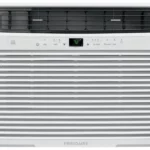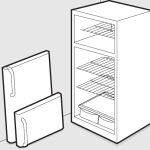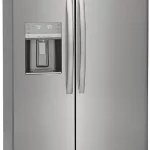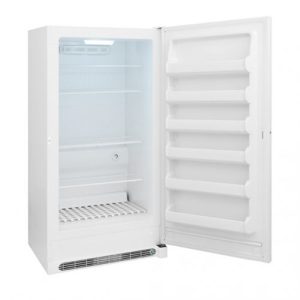

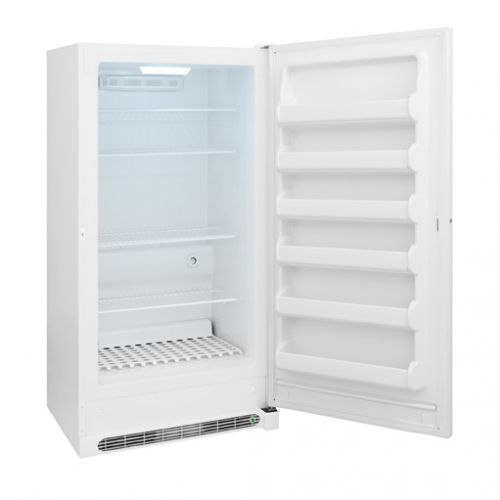
Frigidaire Upright Freezer FFFH20F2QW Manual
Read and save these instructions.
Product Registration
The information contained in this Owner’s Guide will instruct you on how to properly operate and care for your product. Please read through the information contained in your literature pack to learn more about your new appliance.
Record Your Model and Serial Numbers
Record the Model No. and Serial No. of this freezer in the space provided below.
Model No. _______________
Serial No. ________________
Register Your Product
The self-addressed PRODUCT REGISTRATION CARD (shown left) should be filled in completely, signed and returned to Electrolux Home Products. In Canada, return to Frigidaire Canada.
Contents
This Owner’s Guide provides operating instructions for your model. Use your freezer only as instructed in this Owner’s Guide.
Energy Saving Ideas
- The freezer should be located in the coolest area of the room, away from heat producing appliances or heating ducts, and out of direct sunlight.
- Let hot foods cool to room temperature before placing in the freezer. Overloading the freezer forces the compressor to run longer. Foods that freeze too slowly may lose quality or spoil.
- Be sure to wrap foods properly and wipe containers dry before placing them in the freezer. This cuts down on frost build-up inside the freezer.
- Freezer shelves and baskets should not be lined with aluminum foil, wax paper, or paper toweling. Liners interfere with cold air circulation, making the freezer less efficient.
- Organize and label food to reduce door openings and extended searches. Remove as many items as needed at one time, and close door as soon as possible.
© 2000 White Consolidated Industries, Inc. All rights reserved.
Important Safety Instructions
Read all instructions before using this freezer.
For Your Safety
Do not store or use gasoline or other flammable vapors and liquids in the vicinity of this or any other appliance. Read product labels for flammability and other warnings.
Child Safety
- Destroy carton, plastic bags, and any exterior wrapping material immediately after the freezer is unpacked. Children should never use these items for play. Cartons covered with rugs, bedspreads, plastic sheets or stretch wrap may become airtight chambers and can quickly cause suffocation.
- A child might suffocate if he crawls into a freezer to hide or play. Remove the door of a freezer when not in use, even if you plan to discard the freezer. Many communities have laws requiring you to take this safety precaution.
- Remove and discard any spacers used to secure the shelves during shipping. Small objects are a choke hazard to children.
Electrical Information
These guidelines must be followed to ensure that safety mechanisms in the design of this freezer will operate properly.
- Refer to the serial plate for correct electrical rating. The power cord of the appliance is equipped with a three-prong grounding plug for protection against shock hazards. It must be plugged directly into its own properly grounded three prong receptacle, protected with a 15 amp time delay fuse or circuit breaker. The receptacle must be installed in accordance with the local codes and ordinances. Consult a qualified electrician. Receptacles protected by Ground Fault Circuit Interrupters (GFCI) are NOT RECOMMENDED. DO NOT use an extension cord or adapter plug.
- If voltage varies by 10 percent or more, freezer performance may be affected. Operating the freezer with insufficient power can damage the motor. Such damage is not covered under the warranty. If you suspect your household voltage is high or low, consult your power company for testing.
- To prevent the freezer from being turned off accidentally, do not plug unit into an outlet controlled by a wall switch or pull cord.
- Do not pinch, knot, or bend power cord in any manner.
Other Precautions
- Never unplug the freezer by pulling on the power cord. Always grip the plug firmly and pull straight out from the receptacle.
- Turning the control to OFF turns off the compressor, but does not disconnect power to other electrical components.
Proper Disposal of Your Refrigerator/Freezer
Risk of child entrap-ment. Child entrapment and suffocation are not problems of the past. Junked or abandoned refrigerators or freezer are still dangerous — even if they will sit for “just a few days.” If you are getting rid of your old refrigerator or freezer, please follow the instructions below to help prevent accidents.
BEFORE YOU THROW AWAY YOUR OLD REFRIGERATOR/FREEZER:
- Remove doors.
- Leave shelves in place so children may not easily climb inside.
Avoid fire hazard or electric shock. Do not use an extension cord or an adapter plug. Do not remove any prong from power cord.

First Steps
Before starting the freezer, follow these important first steps:

Installation
- Choose a place that is near a grounded electrical outlet.
- For the most efficient operation, the freezer should be located where surrounding temperatures will not exceed 110°F (43°C). Temperatures of 32°F (0°C) and below will NOT affect freezer operation. Additional compressor heaters are not recommended.
- Allow space around the unit for good air circulation. Leave a 3 inch (75 mm) space on all sides of the freezer for adequate circulation.
Leveling
The freezer must have all bottom corners resting firmly on a solid floor. The floor must be strong enough to support a fully loaded freezer. NOTE: It is VERY IMPORTANT for your freezer to be level in order to function properly. If the freezer is not leveled during installatioin, the door may be misaligned and not close or seal properly, causing cooling, frost, or moisture problems.
To Level Upright Unit:
After discarding crating screws and wood base, use a carpenter’s level to level the freezer from front-to-back. Adjust the plastic leveling feet in front, ½ bubble higher, so that the door closes easily when left halfway open.
To Level Chest Unit:
If needed, add metal or wood shims between feet pads and floor.

Cleaning
- Wash any removable parts, the freezer interior, and exterior with mild detergent and warm water. Wipe dry. DO NOT USE HARSH CLEANERS ON THESE SURFACES.
- Do not use razor blades or other sharp instruments, which can scratch the appliance surface when removing adhesive labels. Any glue left from the tape can be removed with a mixture of warm water and mild detergent, or touch the residue with the sticky side of tape already removed. DO NOT REMOVE THE SERIAL PLATE.

Upright Freezer Door Removal
If door must be removed:
- Lift up plastic hinge cover and fold back.
- Use a Phillips® screwdriver to loosen and retighten the screws on the top hinge to ensure that a secure assembly and prevent hinge slippage.
- Remove the top hinge from cabinet and lift door off the lower hinge pin.
- After door is removed, remove the two screws from the bottom hinge.
- To replace door, reverse above order.

Setting the Temperature Control
Cool Down Period
- For safe food storage, allow 4 hours for freezer to cool down completely. The freezer will run continuously for the first several hours. Foods that are already frozen may be placed in freezer after the first few hours of operation. Unfrozen foods should NOT be loaded into freezer until freezer has operated for 4 hours.
- When loading freezer, freeze only 3 pounds of fresh food per cubic foot of freezer space at one time. Distribute packages to be frozen evenly throughout the freezer. It is not necessary to turn control knob to a colder setting while freezing food.
Temperature Control
The temperature control is located inside the freezer on upright models, and on the left outside wall on chest models. The temperature is factory preset to provide satisfactory food storage temperatures. However, the temperature control is adjustable to provide a range of temperatures for your personal satisfaction. If a colder temperature is desired, turn the temperature control knob toward COLDEST and allow several hours for temperatures to stabilize between adjustments.
NOTE: Your freezer may have some, or all of the features listed below. Become familiar with these features, and their use and care.
Freezer Optional Features

Power On Light
The Power On Light indicates that the freezer is properly connected to electrical power. The light glows even when the temperature control is turned to OFF. If the light goes out, refer to “Freezer does not run” in the Avoid Service Checklist.
Temp Alarm (audible only or audible with warning light)
This feature is designed to provide a warning of possible malfunction. If the temperature of the food rises to a level unsafe for long-term storage, the buzzer will sound. The red light will also glow on models so equipped. The Temp Alarm feature operates on household electricity. If power fails, the alarm will not perform. An ON/ OFF switch allows you to deactivate the Temp Alarm when not wanted. The freezer is shipped with Temp Alarm in the OFF position. After freezer has run approximately 4 hours, the red light, if equipped, will go off. Then you may activate the Temp Alarm without the alarm sounding.
Press the ON switch to activate the Temp Alarm. To deactivate, press the OFF switch.
If the alarm sounds, be sure freezer is properly leveled, and the door closes freely, and seals properly. If you suspect a technical malfunction, call an authorized servicer immediately.
Power Cord Clamp
The clamp prevents the power cord from being accidently unplugged. Remember when removing or replacing the electrical cord, to remove or replace the power cord clamp.
Power Freeze
Power Freeze allows you to lower your freezer temperature to the lowest possible temperature by pushing the switch to ON. For maximum benefit, Power Freeze should be selected 24 hours before placing a large quantity of unfrozen food into freezer. Food should then be spread throughout freezer compartment to speed up the freezing process. To turn off Power Freeze, manually push the switch to OFF. (This will return compressor to the normal operating mode.)

Power Defrost
The Power Defrost feature will defrost freezer in a fraction of the time usually required. To defrost, remove all food, and follow these steps.
- Pull out Power Defrost Plunger. Leave door open while defrosting. (Closing freezer door will push in plunger and power defrost will be turned off.)
- Push Power Defrost Plunger in to restart freezer after defrosting is completed.
NOTE: When defrosting units with the Temp Alarm Feature, turn off the alarm when defrosting. When the freezer reaches the freezing temperature, turn the Temp Alarm back on.

Slide-Out Basket (upright models)
The Slide-Out Basket, located at the bottom of the freezer provides separate storage space for items that are difficult to store on freezer shelves. To remove the basket, pull out, and lift up.
Juice Can Rack (upright models)
The Juice Can Rack on the freezer door is specially ridged to store juice cans and prevent them from rolling out of the shelf.
Security Lock with Pop-Out Key
This security lock fastens the door snugly, ensuring that stored food is secure. To lock or unlock the freezer, push the key into the lock and turn. The key pops out of the lock after it has been turned.
Interior Light
The light comes on automatically when the door is opened. To replace the light bulb, turn the temperature control to OFF and unplug the electrical cord. Replace the old bulb with a bulb of the same wattage.
Adjustable Shelf (upright models)
This shelf can be moved to one of two positions. Lift the shelf up and out to move to the desired position.
Defrost Drain
The defrost drain provides a method of draining the water during defrosting and cleaning. See “Defrosting” in Care and Cleaning Section.
Slide-Aside Basket (chest models)
This basket helps organize odd-shaped items. To reach other packages in the freezer, slide the basket aside or lift out.
Divider/Drain Pan (chest models)
The Divider/Drain Pan doubles as a convenient storage area and serves as a shallow drain pan when defrosting. To remove, lift pan straight up out of the supports, and out of the chest.
Fast Freezing Shelves (upright models)
These shelves contain cooling coils to freeze foods quickly and allow cold air to constantly circulate throughout the freezer. Do not use sharp metal objects such as ice picks or scrapers to clean the shelves. This could damage the shelves and reduce their cooling ability. These shelves are not adjustable.
Tilt-Out Shelf
This shelf is located inside on the freezer door and provides additional storage space.
To access an item, tilt top of “basket” shelf down.
Drop Front Shelf (upright models)
The Drop Front Shelf, located at the bottom of the freezer, provides a separate compartment for small irregular shaped items or large, bulky items. Lift the shelf front up and out to remove.
Care and Cleaning
Caution: Damp objects stick to cold metal surfaces. Do not touch interior metal surfaces with wet or damp hands

WARNNING: If leaving freezer door open while on vacation, make certain that children cannot get into the freezer and become entrapped. Some upright freezers are frost-free and defrost automatically, but should be cleaned occasionally.
Between Defrostings
To avoid frequent defrosting, occasionally use a plastic scraper to remove frost.
Scrape with a pulling motion. Never use a metal instrument to remove frost.
Defrosting
It is important to defrost and clean freezer when ¼ to ½ inch of frost has accumulated. Frost may tend to accumulate faster on upper part of the freezer due to warm, moist air entering the freezer when the door is opened. Remove food and leave the door open when defrosting the freezer.
- On upright models with a defrost drain (Figure 1), remove drain plug on the inside floor of the freezer by pulling straight out. To access external drain tube on models with a base panel, first remove the two screws from the base panel. Locate the drain tube near the left center under the freezer. Place a shallow pan under the drain tube. Defrost water will drain out. Check pan occasionally so water does not overflow. A ½ inch garden hose adapter can be used to drain the freezer directly into a floor drain. If your model is not equipped with an adapter, one can be purchased at most hardware stores. Replace the drain plug when defrosting and cleaning are completed. If the drain is left open, warm air may enter freezer.
- On chest models with a defrost drain, place a shallow pan or the Divider/Drain Pan (some models) beneath the drain outlet (Figure 2). A ½ inch garden hose adapter can be used to drain the freezer directly into a floor drain (Figure 3). If your model is not equipped with an adapter, one can be purchased at most hardware stores. Pull out the drain plug inside the freezer, and pull off the outside defrost drain plug (Figure 4). Defrost water will drain out. Check pan occasionally so water does not overflow. Replace the drain plugs when defrosting is completed.
- On models without a defrost drain, place towels or newspapers on the freezer bottom to catch the frost. The frost will loosen and fall. Remove towels and/or newspapers.
- If the frost is soft, remove it by using a plastic scraper. If the frost is glazed and hard, fill deep pans with hot water and place them on the freezer bottom. Close the freezer door. Frost should soften in about 15 minutes. Repeat this procedure if necessary.
Cleaning the Inside
After defrosting, wash inside surfaces of the freezer with a solution of two tablespoons of baking soda in one quart (1.136 litres) warm water. Rinse and dry. Wring excess water out of the sponge or cloth when cleaning in the area of the controls, or any electrical parts. Wash the removable parts and door basket with the baking soda solution mentioned above, or mild detergent and warm water. Rinse and dry. Never use metallic scouring pads, brushes, abrasive cleaners, or alkaline solutions on any surface. Do not wash removable parts in a dishwasher.
Cleaning the Outside
Wash the cabinet with warm water and mild liquid detergent. Rinse well and wipe dry with a clean soft cloth. Replace parts and food.
Vacation and Moving Tips
Short Vacations: Leave the freezer operating during vacations of less than three weeks.
Long Vacations: If the freezer will not be used for several months, remove all food and unplug the power cord. Clean and dry the interior thoroughly. To prevent odor and mold growth, leave the freezer door open slightly, blocking it open if necessary.
Moving: Disconnect the power cord plug from the wall outlet. Remove foods, then defrost, and clean the freezer. Secure all loose items such as base panel, baskets, and shelves by taping them securely in place to prevent damage. In the moving vehicle, secure freezer in an upright position, and secure to prevent movement. Also protect outside of freezer with a blanket, or similar item.
Power Failure/Freezer Failure
Do not open freezer door unnecessarily if freezer is off for several hours.
If a power failure occurs, frozen foods will stay frozen for at least 24 hours if the freezer is kept closed. If the power failure continues, pack seven or eight pounds of dry ice into the freezer every 24 hours. Look in the Yellow Pages under “Dry Ice,”
“Dairies,” or “Ice Cream Manufacturers” for local dry ice suppliers. Always wear gloves and use caution when handling dry ice.
If the freezer has stopped operating, see “Freezer does not run” in the Avoid Service Checklist Section of this manual. If you cannot solve the problem, call an authorized servicer immediately.
If the freezer remains off for several hours, follow the directions above for the use of dry ice during a power failure. If necessary, take the food to a local locker plant until the freezer is ready to operate. Look in the Yellow Pages under “Frozen Food Locker Plants.”
Avoid Service Checklist
Before calling for service, review this list. It may save you both time and expense. This list includes common occurrences that are not the result of defective workmanship or materials in this appliance.
OCCURRENC SOLUTION
FREEZER DOES NOT RUN
Check to ensure that freezer is not plugged into a circuit that has ground fault interrupt. If you are unsure about the outlet, have it checked by a certified technician. Temperature control is in the OFF position. See Setting the Temperature Control Section.
Freezer may not be plugged in, or plug may be loose. Be sure plug is tightly pushed into electrical outlet.
House fuse has blown, or circuit breaker has tripped. Check/reset circuit breaker, or replace fuse with 15 amp. time delay fuse.
Power outage. Check house lights. Call local electric company
Freezer runs too much or too long.
Room or outside weather is hot. It is normal for the freezer to work harder under these conditions.
Freezer had recently been disconnected for a period of time. Freezer requires 4 hours to cool down completely.
Large amounts of warm or hot food have been stored recently. Warm food will cause the freezer to run more until the desired temperature is reached.
Door is kept open too long or too frequently. Warm air enters the freezer every time the door is opened. Open the door less often.
Freezer door may be slightly open. See Occurrence “Door Problems.”
Temperatures inside the freezer are too cold.
Temperature control is set too cold. Turn the control knob to a warmer setting. Allow several hours for the temperature to stabilize.
Freezer gasket is dirty, worn, cracked, or poorly fitted. Clean or change gasket. Leaks in the door seal will cause freezer to run longer in order to maintain desired temperature.





FAQS
Is this upright freezer frost free?
It is a manual defrost unit. BTW manual defrost units have some benefits – less expensive to operate (use less electricity) and frost free freezers tend to dry the frozen foods out.
How do I know if my freezer is working properly?
The freezer should be kept at 0°F (-18°C). If the temperature rises above 0°F (-18°C), it is working properly. If the temperature falls below 0°F (-18°C), there may be a problem with the freezer. Check the temperature with an appliance thermometer. If the freezer is not working properly, contact your dealer or call 1-800-898-9099 for assistance.
How do I defrost my freezer?
The automatic defrost system keeps frost from building up on the evaporator coils. This system works by automatically turning off the compressor and allowing frost to melt and drip into a pan. When the pan becomes full, it will automatically shut off and allow the compressor to start again. This cycle will continue until all of the frost has melted. It is normal for some frost to remain in the pan after a cycle has completed. If you have questions about your automatic defrost system, contact your dealer or call 1-800-898-9099 for assistance.
What are some tips for using my freezer?
Let hot foods cool to room temperature before placing in the freezer. Overloading the freezer forces the compressor to run longer. Foods that freeze too slowly may lose quality or spoil. Be sure to wrap foods properly and wipe containers dry before placing them in the freezer. This cuts down on frost build-up inside the freezer. Frozen foods should be stored in airtight containers or heavy-duty plastic bags to prevent loss of flavor and moisture from open packages. Frozen foods should be stored at 0°F (-18°C) or lower to maintain quality and food safety. Higher temperatures can cause loss of flavor and nutrition, as well as shorten shelf life of frozen foods. Use an appliance thermometer to check that your freezer’s temperature is consistently at 0°F (-18°C). Do not store carbonated beverages in your freezer because they may explode due to buildup of pressure caused by freezing temperatures. Do not store medications in your freezer because they may become less effective if exposed to freezing temperatures; check with your pharmacist for more information on how cold temperatures can affect medications you take regularly. LIMITATION OF LIABILITY: THIS MANUAL IS PROVIDED FOR GENERAL INFORMATION ONLY AND IS NOT TO BE CONSTRUED AS A WARRANTY OR REPRESENTATION BY ELECTROLUX HOME PRODUCTS INC., ITS AGENTS OR EMPLOYEES REGARDING THE DESIGN, CONSTRUCTION, QUALITY OR PERFORMANCE OF YOUR FRIGIDAIRE FREEZER (MODEL NUMBER) OR ANY ACCESSORIES THAT MAY BE SOLD WITH IT (EITHER SEPARATELY OR AS
How many watts per hour?
88
Why is my freezer all frosted?
Moisture from room ambient air entering the freezer and freezing (make sure the door is closed properly and is sealing properly) – try closing the door on a piece of paper and see if it is difficult to pull out….that’s a good test of the door seal. You can also lubricate the gasket with a bit of Vaseline to make it seal better.
Check the freezer door alignment to make sure the door lines up perfectly with the freezer body.
Frost is caused by the moisture in foods you are freezing evaporating and condensing on the walls of the freezer. Make sure you are sealing foods you are freezing well.
Frost is caused by the moisture in room air condensing and freezing when the freezer door is opened. Try to open the freezer door as little as possible and for as short a time as possible.
Can we used this freezer with regular outlets?
The unit is designed to be powered by a 120V 60Hz 15A outlet (typical in most homes and offices).
How long does it take before you have to defrost it?
The frequency of defrosting is dependent upon the relative humidity in the unit location, how often and how long the door is opened, the moisture content of the foods stored in the freezer and the tightness of the door seal.
Make sure the unit is level.
The door seal can be adjusted via the hinges.
The unit can be levelled by adjusting the legs.
Make sure frozen foods are packaged tightly in plastic bags.
Does the Frigidaire Upright 6.5 cu ft Freezer use a standard 3-prong wall socket plug?
Yes. The unit is designed to be plugged into a standard North American 120V 60 Hz 15A 3 prong AC receptacle.
On 3 cu ft model what are dimensions inside the unit for each of 3 shelf areas?
The two top areas are 16″ wide by 7″ high and @ 15″ deep. The bottom section is 16 wide by 9″ high but only @ 7″ deep.
for the 1.1 cu ft, the description says 3 wire shelves and the photo shows 1 wire shelf. Which is correct?
The unit has 1 wire shelf – the error is being corrected.
does this freezer need to be on it’s own circuit?
The unit is designed to be plugged into a 120V AC 60Hz 15Amp circuit – it is strongly suggested that no other appliances be plugged into the circuit.
Is there any product insurance to buy for this freezer?
No
Does this fridge need its own circuit in the circuit breaker box?
The unit is designed to be plugged into a 120V 60Hz 15A circuit. It is not recommended that other appliances be plugged into the same circuit.
Is this energy star rated?
The unit uses 304 kWh per year
Will it hold a 1/2 gallon of ice cream?
In this freezer , you can store 1/2 gallon of ice cream easily but the size of package or container matters .Because the shelves are fixed so you can not move .
Are the shelves removable?
No they are not removable
Can this be installed as an under-counter freezer?
Allow 12.7 cm (5 inches) of space between the back of the appliance and the wall. Allow 5 cm (2 inches) between the sides and top of the appliance and any walls or counter tops. This appliance is intended for free-standing installation only and IS NOT intended to be built into a cabinet or counter. Building in this appliance can cause it to malfunction.
Can we use regular outlets?
The unit is designed to be powered by a 120V 60Hz 15A outlet (typical in most homes and offices).
how many amps does the 6.5 freezer pull?
The unit is designed to be plugged into its own 120V 60Hz 15A outlet. The unit uses 304 kWh = 34.7W on average.
The unit should not be powered by an inverter.
